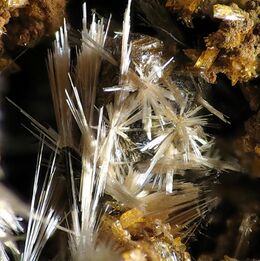Chemistry:Strunzite
From HandWiki
| Strunzite | |
|---|---|
 Strunzite from Bavaria, Germany | |
| General | |
| Category | Mineral |
| Formula (repeating unit) | Mn2+Fe3+2(PO4)2(OH)2 · 6H2O[1] |
| Strunz classification | 8.DC.25 |
| Crystal system | Triclinic |
| Space group | P1 (no. 2) |
| Unit cell | a = 10.228(5) [Å], b = 9.837(5) [Å] c = 7.284(5) [Å]; α = 90.17(5)° β = 98.44(5)° γ = 117.44(5)°; Z = 2[2] |
| Identification | |
| Color | Straw yellow to brownish yellow |
| Crystal habit | Acicular[3] |
| Mohs scale hardness | 4 |
| |re|er}} | vitreous |
| Streak | white |
| Specific gravity | 2.52 |
| Density | 2.52 g/cm3 |
| Pleochroism | Weak |
| References | [4][5] |
Strunzite (Mn2+Fe3+2(PO4)2(OH)2 · 6H2O) is a light yellow mineral of the strunzite group, first discovered in 1957.[4]
It crystallizes in the triclinic system and has a light, vitreous luster, a specific gravity of 2.52 and a Mohs hardness of 4. Associated minerals include beraunite, quartz and strengite.[4]
It is named after Hugo Strunz, a Professor of Mineralogy at Technical University, Berlin.[7]
References
- ↑ "Strunzite R050619". https://rruff.info/Strunzite. Retrieved 8 April 2020.
- ↑ "Strunzite Mn2+Fe3+2(PO4)2(OH)2•6H2O". http://www.handbookofmineralogy.org/pdfs/strunzite.pdf. Retrieved 8 April 2020.
- ↑ "General Strunzite Information". http://webmineral.com/data/Strunzite.shtml#.Xo4E0jKQxpg. Retrieved 8 April 2020.
- ↑ 4.0 4.1 4.2 "Strunzite". https://www.mindat.org/min-3810.html. Retrieved 8 April 2020.
- ↑ Grey, I. E.; Macrae, C. M.; Keck, E.; Birch, W. D. (October 2012). "Aluminium-bearing strunzite derived from jahnsite at the Hagendorf-Süd pegmatite, Germany". Mineralogical Magazine 76 (5): 1165–1174. doi:10.1180/minmag.2012.076.5.08. Bibcode: 2012MinM...76.1165G.
- ↑ Warr, L.N. (2021). "IMA–CNMNC approved mineral symbols". Mineralogical Magazine 85 (3): 291–320. doi:10.1180/mgm.2021.43. Bibcode: 2021MinM...85..291W.
- ↑ "Strunzite". https://www.dakotamatrix.com/mineralpedia/7310/strunzite. Retrieved 8 April 2020.
 |
